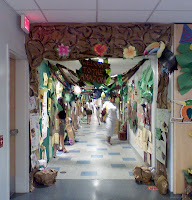The picture of the calla lily above is from my garden. I have always loved to garden. When I was a child I used to take care of the rose bushes around the dog pen. I loved twining the roses in between the posts, and I looked forward to seeing the fruits of my labor.
Now, as an adult with my own home, I am gardening again. I grow your usual food: tomatoes, lettuce, peppers, spinach, collards, pak choi, carrots, radishes... etc. Sometimes things go really well; other times I deal with vermin, like Kehli who loves to slurp the centers out of just ripe tomatoes that she has harvested. As a result, I have put up fences around some of the beds, and have moved several of the planters out of the main yard.
But, my pride and joy are my flowers. I am not one of those people who loves perfectly landscaped gardens. Instead I inspire to a riot of colors and plants. Sometimes I am successful, sometimes not.
Last year was the first year I put in the back bed. I was so proud of myself. While I didn't put in the wall, I did pick, lay out and put in all the plants. It was a very pretty garden, and I had a number of plants that simply thrived. Still, I had others that failed to do well, and they had to be replaced this year. Even so, my first efforts were very pretty, and oh-so-neat.
Of course this year, the garden is out of control. I LOVE IT. It is a riot of plants, colors, and scents. I am very happy with it, and am planning to do a lot more work with it this summer. Of course, there is the usual work that needs to be done: weeding, trimming, hacking back, pinching, deadheading, fertilizing... it's a never ending process. But it's the daily, small stuff that makes the garden beautiful. It's also these daily chores that help the garden to thrive. Without this daily maintenance, the plants crowd each other, fighting for sun, the weeds choke emerging plants, and it just looks bad. You can never let it get away from you.
Teaching, in this respect, is much like gardening. It takes a lot of preparation beforehand to have a successful classroom. Just like you have to prep the soil, you need to set up a strong foundation for your students. You need to follow planting directions and meet the soil quality, water, and sun needs of each plant. You need to leave adequate room for the plant to spread. It's the same with students. They each have their own strengths and needs, and teachers must know what they are and meet them if their students are to thrive. And like gardens, there is a routine of things that must be done. In classrooms we need to reinforce new learning and ensure that the foundation remains strong.
Ultimately though, we need to decide what type of classroom we want. Do we need absolute order and try to bend Mother Nature to our will? Do we enjoy watching Mother Nature do what she does best? As teachers, we need to make the same decisions. We can quash children's curiosity and make them walk on the lines, sit in rows and never speak until spoken to. Or, we can encourage them to be who they are in all their messy glory. Some children will be quiet and understated like my ornamental bamboo, and others will be bigger than life like my climbing rose. Either way, we need to nurture our students. That's what teaching is all about.







